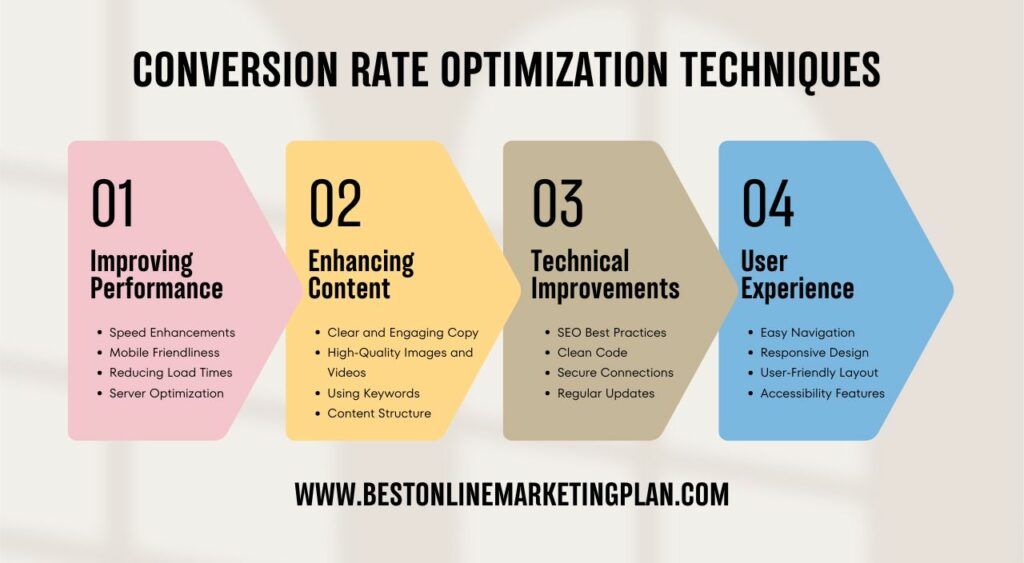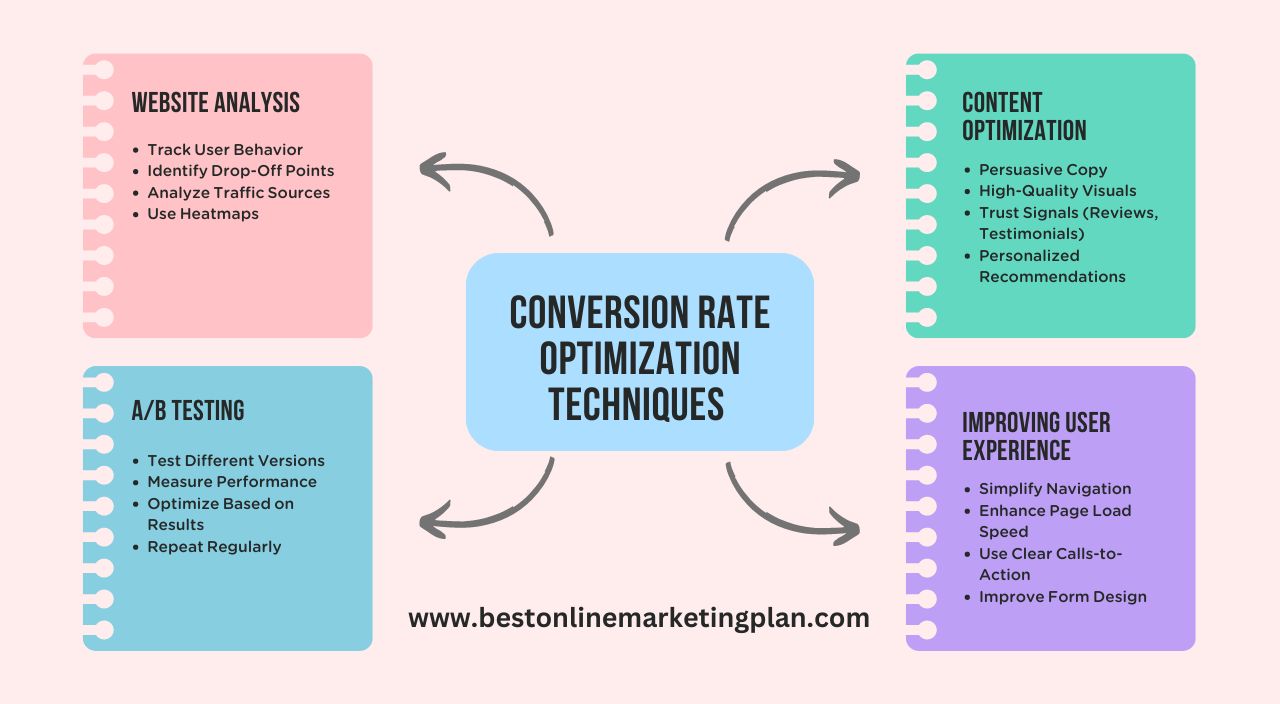Introduction
Understanding Conversion Rate Optimization
What is Conversion Rate Optimization?
Conversion Rate Optimization (CRO) is the systematic process of increasing the percentage of website visitors who take a desired action — be it filling out a form, becoming customers, or otherwise. It’s a critical aspect of digital marketing that focuses on enhancing the effectiveness of your website.
Why Conversion Rate Optimization Matters
CRO matters because it directly impacts your bottom line. By improving your conversion rate, you can get more value from your existing traffic. Instead of spending more on advertising to drive traffic, you can focus on converting the traffic you already have. This not only increases sales but also improves overall marketing efficiency.
Setting the Stage: Analyzing Your Current Conversion Rate
How to Measure Your Current Conversion Rate
To improve anything, you first need to measure it. Start by using tools like Google Analytics to track your current conversion rate. Identify the baseline metrics: the number of visitors, conversion events, and conversion rate percentage.
Identifying Key Metrics for Optimization
Determine the key metrics that matter most to your business. These could include the bounce rate, average session duration, or specific funnel drop-off points. Focusing on these metrics will help you identify where to make impactful changes.
User Experience: The Foundation of Conversion Success
Simplifying Navigation for Better Conversions
A cluttered website can overwhelm visitors. Simplify your navigation to help users find what they’re looking for quickly. Clear menus, intuitive layout, and accessible search functionality can significantly enhance user experience and drive conversions.
The Power of Fast Loading Times
Speed is crucial. A slow website frustrates users and leads to high bounce rates. Optimize images, leverage browser caching, and use Content Delivery Networks (CDNs) to ensure your website loads quickly.

Mobile Optimization: Reaching On-the-Go Users
With the increasing number of mobile users, ensuring your website is mobile-friendly is imperative. Responsive design, fast mobile load times, and easy-to-tap buttons can dramatically improve mobile conversions.
Crafting Compelling Calls-to-Action
Creating Clear and Actionable CTAs
Your Call-to-Action (CTA) should be clear, concise, and compelling. Use strong action words that encourage immediate response, such as “Buy Now,” “Sign Up Today,” or “Get Started.”
Strategic Placement of CTAs
Place your CTAs where they are most likely to be seen. Above the fold, at the end of blog posts, and within product descriptions are strategic spots. Ensure they stand out visually without being intrusive.
Using Urgency and Scarcity to Drive Actions
Leverage psychological triggers like urgency and scarcity to boost conversions. Phrases like “Limited Time Offer” or “Only a Few Left” can prompt visitors to act quickly.
A/B Testing: The Secret Weapon
What is A/B Testing and Why It’s Crucial
A/B testing involves comparing two versions of a webpage or app to see which one performs better. It’s a powerful way to understand what works best for your audience.
How to Conduct Effective A/B Tests
Create two versions of a webpage element (A and B) and split your traffic between them. Monitor which version yields better results in terms of conversion goals. Test one element at a time to clearly attribute changes in performance.
Interpreting A/B Test Results
Analyze the data from your A/B tests to draw actionable insights. Look for statistically significant results to ensure the changes you implement will positively impact your conversion rate.
Landing Page Optimization Techniques
Designing High-Converting Landing Pages
A well-designed landing page can significantly boost your conversion rate. Focus on a clean design, compelling headlines, and a clear value proposition.
Utilizing Visual Hierarchy for Better Engagement
Use visual hierarchy to guide visitors’ attention to the most important elements first. Larger fonts for headlines, contrasting colors for CTAs, and strategic use of whitespace can enhance readability and focus.
Writing Persuasive and Relevant Content
Content is king. Write content that speaks directly to your audience’s needs and pain points. Use persuasive language that clearly outlines the benefits and value of your offer.
Leveraging Social Proof for Credibility
How Testimonials and Reviews Impact Conversions
Social proof, such as testimonials and reviews, builds trust and credibility. Highlight positive feedback from satisfied customers to reassure potential clients of your product’s value.
Case Studies: Real-World Examples of Success
Detailed case studies that showcase how your product or service has helped other clients can be incredibly persuasive. Include metrics and specific outcomes to provide concrete evidence of your effectiveness.
Personalization: Making Users Feel Special
Implementing Personalization Strategies
Personalize your website experience based on user behavior, demographics, and preferences. Tailored content, product recommendations, and personalized emails can make users feel valued and more likely to convert.
Dynamic Content to Match User Preferences
Use dynamic content to display different messages or products based on user preferences and past interactions. This approach makes your marketing efforts more relevant and engaging.
Improving Forms for Higher Submissions
Reducing Form Fields for Better Completion Rates
Long forms can be daunting. Reduce the number of fields to the essentials to increase the likelihood of form completion. Consider using multi-step forms to break the process into manageable chunks.
Enhancing Form Design for User Friendliness
Design forms with user experience in mind. Ensure fields are clearly labeled, use placeholder text for guidance, and implement error messages that help users correct mistakes easily.
Optimizing Checkout Processes
Simplifying Checkout for E-commerce Success
A complicated checkout process can lead to cart abandonment. Simplify steps, offer guest checkout options, and provide multiple payment methods to streamline the process.
Reducing Cart Abandonment Rates
Use strategies like cart abandonment emails, exit-intent popups, and incentives (e.g., free shipping) to encourage users to complete their purchases.
Effective Use of Visuals and Media
Using Images and Videos to Boost Engagement
Visual content can be more engaging than text alone. Use high-quality images and videos to capture attention and convey your message effectively.
Infographics: Simplifying Complex Information
Infographics are a great way to present complex information in an easy-to-understand format. They can simplify data and make your content more shareable.
Crafting High-Converting Copy
Writing Headlines That Capture Attention
Your headlines need to grab attention and make users want to read more. Use powerful words, ask intriguing questions, or promise valuable information.
Creating Benefit-Focused Content
Focus on the benefits your product or service offers rather than just features. Highlight how it can solve problems or improve the lives of your customers.
Building Trust with Security and Privacy
Displaying Trust Badges and Certificates
Show trust badges, security seals, and certifications prominently on your site. This reassures visitors that their data is safe and secure.
Communicating Your Privacy Policies Clearly
Be transparent about how you handle user data. Clearly explain your privacy policies and ensure users know their information is protected.
Retargeting Strategies to Recapture Lost Leads
How Retargeting Works
Retargeting involves showing ads to users who have previously visited your site but did not convert. It keeps your brand top-of-mind and encourages them to return.
Best Practices for Effective Retargeting Campaigns
Segment your audience, use personalized ads, and set frequency caps to avoid overexposure. Tailor your messaging based on the user’s previous interactions with your site.
Harnessing the Power of Email Marketing
Building an Email List for Better Conversions
An email list is a valuable asset. Use lead magnets like free guides, discounts, or exclusive content to encourage sign-ups.
Crafting Emails That Drive Action
Write compelling subject lines, provide valuable content, and include clear CTAs. Personalize your emails to increase engagement and conversions.
Analyzing and Using Data for Continuous Improvement
Leveraging Analytics Tools for Insights
Use tools like Google Analytics to gather data on user behavior. Identify patterns, track conversions, and uncover areas for improvement.
Implementing Data-Driven Changes
Make informed decisions based on your analytics data. Continuously test and refine your strategies to achieve better results over time.
The Role of Customer Support in Conversions
Offering Live Chat for Immediate Assistance
Live chat can provide immediate answers to user questions, helping to overcome objections and facilitate conversions.
Improving Response Times for Better User Experience
Quick response times are crucial. Ensure your support team is well-equipped to handle inquiries promptly and efficiently.
Integrating Social Media to Drive Traffic and Conversions
How Social Proof on Social Media Boosts Conversions
Showcasing positive interactions and testimonials on social media can build trust and influence potential customers.
Engaging Content Strategies for Social Platforms
Create and share engaging content tailored to each social media platform. Use a mix of promotional, educational, and entertaining content to keep your audience engaged.
Case Studies: Real-Life Success Stories
Analyzing Successful Conversion Optimization Campaigns
Review successful campaigns from various industries. Identify the common elements that contributed to their success and apply these insights to your efforts.
Lessons Learned from Leading Brands
Learn from the strategies used by top brands. Understand how they implement CRO techniques and adapt these strategies to fit your business model.
Future Trends in Conversion Rate Optimization
Emerging Technologies and Techniques
Stay updated on the latest trends and technologies in CRO. Innovations like AI-driven personalization and advanced analytics tools can offer new ways to optimize conversions.
Staying Ahead of the Curve
Continuously educate yourself and stay informed about industry changes. Being proactive and adaptable will help you maintain a competitive edge.

